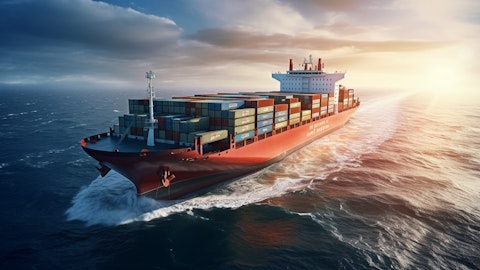Ardmore Shipping Corporation (NYSE:ASC) Q3 2025 Earnings Call Transcript November 5, 2025
Ardmore Shipping Corporation beats earnings expectations. Reported EPS is $0.31, expectations were $0.28.
Operator: Good morning, ladies and gentlemen, and welcome to Ardmore Shipping’s Third Quarter 2025 Earnings Conference Call. Today’s call is being recorded, and an audio webcast and presentation are available in the Investor Relations section of the company’s website, ardmoreshipping.com. [Operator Instructions] A replay of the conference call will be accessible through November 12 by dialing 1 (888) 660-6345 or 1 (646) 517-4150 and entering passcode 96494. At this time, I will turn the call over to Gernot Ruppelt, Chief Executive Officer of Ardmore Shipping.
Gernot Ruppelt: Good morning, and welcome to Ardmore Shipping’s Third Quarter 2025 Earnings Call. First, let me ask our President, Bart Kelleher, to discuss forward-looking statements.
Bart Kelleher: Thanks, Gernot. Turning to Slide 2. Please allow me to remind you that our discussion today contains forward-looking statements. Actual results may differ materially from those projected in the forward-looking statements. Additional information concerning factors that could cause the actual results to differ materially from those in the forward-looking statements is contained in the third quarter 2025 earnings release, which is available on our website. And now back over to Gernot.
Gernot Ruppelt: Thank you, Bart. Let me outline the format of today’s call, which you can see here on Slide 3. First, I’ll give you a brief overview of third quarter results, market trends and how we are executing on capital allocation. I will then hand over to Bart, who will cover the market outlook and update you on our financial and operating performance. Thereafter, I will conclude the presentation before opening up the call for questions. Turning first to Slide 4. We’re pleased to announce our third quarter results, delivering adjusted earnings of $12.6 million or $0.31 per share. Earnings increased throughout the third quarter and into the fourth, driven by record volumes of refined product on the water. Our TCE performance remains exceptionally strong, defying seasonal norms.
Rates have been firming throughout the year and into the typically stronger winter period at levels more than double our cash breakeven. Our MRs earned $24,700 per day for the third quarter and $24,900 so far in the fourth quarter with 40% booked. Our chemical tankers earned $22,600 per day for the third quarter and $22,200 so far in the fourth quarter with 35% booked. We took delivery of 3 modern MR tankers during the quarter. These were opportunistically acquired during a period of market uncertainty before the summer. Secondhand prices have been firming considerably since. These vessels have been capturing strong spot markets, notable fuel savings and increased our earnings power. Meanwhile, guided by our capital allocation policy, we have fully redeemed our 30 million preferred shares, further reducing our cash breakeven.
And we are declaring our 12th consecutive dividend, consistent with our policy of paying out 1/3 of adjusted earnings. In addition, we are further enhancing the value of our trading book through high-quality long-term charter contracts. We recently fixed one of our 2014-built MRs for 2 years to an oil major at $21,250 per day. Looking ahead, markets are experiencing evolving product tanker demand, significant near-term disruption and tight supply-demand balances, as Bart will cover in greater detail. Turning to Slide 5, where we highlight our disciplined and deliberate approach to capital allocation. We continue to balance returning capital to shareholders with growing the business and reinvesting in our fleet, while maintaining low debt levels.
As just mentioned, we are paying our 12th consecutive dividend. We fully redeemed $30 million of preferred shares, and we took delivery of 3 high-performing MRs. With that, over to Bart.

Bart Kelleher: Thanks, Gernot. Turning to Slide 7 and the market outlook. Export volumes in refined product and transit reached record levels during the quarter, fueling robust product tanker demand. In addition, ample oil supply is driving strong refinery throughput and trading activity. At the same time, high crude fleet utilization is tightening supply across the tanker industry. Notably, 50% of the LR2 fleet is now trading in the crude market, up 23% over the past year. Turning to Slide 8, where we examine how geopolitical factors are creating further inefficiencies and favorably impacting the market. 16% of the global tanker fleet is now sanctioned, significantly reducing the pool of compliant vessels and limiting available supply.
Looking ahead to the start of next year, the EU is further tightening restrictions, targeting products refined from Russian crude. The map on the lower right highlights one example of notably longer voyage distances that are likely to emerge. Meanwhile, rapid changes to geopolitical conflicts, tariffs and trade disruptions are driving increased market activity. Slide 9 highlights the favorable supply dynamics with positive trends on both ends of the age spectrum, an increasingly older fleet and a shrinking order book with decelerating ordering activity. Our favorite chart on the left illustrates the continued evolution of the aging MR fleet over time. The fleet is the oldest it’s been this century. Ongoing regulatory uncertainties continues to limit ordering activity with the order book now representing just 13% of the fleet.
Moving to the chart on the right, the older MR fleet approaching the scrapping window is 4x larger than the current order book. As a reminder, even if these vessels are not initially scrapped, their utilization levels notably decline. Now moving to Slide 10. Here, we take a closer look at evolving trade flows and long-term demand. The global refinery base continues to shift with capacity expansion concentrated in Asia and the Middle East, while closures persist in the West. In Europe and the U.S., refinery shutdowns are increasingly requiring long-haul substitution flows from the East, driving ton-mile demand. Specifically in California, refined product imports are up 50% year-on-year with some major refineries now permanently shutting down.
Meanwhile, forecasts note extended oil demand growth, supported by an increased focus on energy security and continued economic growth. Now moving to Slide 12 and turning our attention to Ardmore’s strong financial performance. As previously mentioned, we’ve utilized our low-cost debt to fully redeem our preferred shares. As a reminder, this was from a 2021 bilateral transaction done directly with our friends at Maritime Partners. Redeeming these shares supports our evolving capital structure and focus on low cash breakeven levels. Once again, the chart on the bottom left highlights the progress we have made to reduce our cash breakeven levels to $11,700 per day. This includes CapEx for drydocking cycles. Without this, our breakeven is an even lower $10,800 per day on an operating basis.
Turning to Slide 13 for financial highlights. For the third quarter, we reported EBITDAR of $27.6 million, and as mentioned earlier, earnings per share of $0.31. We continue to frame EBITDAR as an important comparable valuation metric against our IFRS reporting peers. Full reconciliation details can be found in the appendix on Slide 22. Also, please refer to the appendix on Slide 23 for our fourth quarter guidance numbers. And most importantly, our strong operating leverage positions Ardmore to take advantage of market volatility. Every $10,000 a day in additional TCE increases annual earnings by approximately $2.15 per share. Moving to Slide 14 for fleet operations. Drydocking activity for the year is largely complete with very limited dockings in the coming years, resulting in more revenue days, earnings power and cash generation.
As a reminder, capital expenditures for 2025 are projected to be $37 million, nearly half of which is elective CapEx related to efficiency and tank coating upgrades, projects where we are already realizing notable early returns. Our strong spot exposure is further enhanced through high-quality charter contracts at attractive levels. We’re continuing to invest in tangible AI and digitalization projects with short paybacks. For example, we’re currently upgrading high-frequency data collection and transmission across our fleet to take voyage optimization to the next frontier. Our targeted use of biofuel bunker supports trading strategies in the EU, and we are achieving full fuel EU compliance across the fleet in 2025. Finally, our on-hire availability was a strong 99% in the third quarter, a testament to our seafarers working in coordination with our global team.
With that, I’m happy to hand the call back to Gernot and look forward to answering any questions at the end.
Gernot Ruppelt: Thank you, Bart. Moving to Slide 16. Let me summarize. Earnings have continued to strengthen through the first 3 quarters of 2025 and into the fourth quarter, supported by favorable market conditions and strong operating performance. Our recent acquisitions are capturing these favorable markets and increase Ardmore’s earnings power. We are wrapping up our CapEx program for the year with a minimal drydock schedule for the coming 2 years, and we continue to enhance the quality of our trading book with compelling long-term charters. Our strong financial position enables us to be opportunistic and resilient, giving us the flexibility to both reinvest in the business and deliver shareholder returns. As always, our actions are guided by industry-leading governance. and we take an agile and responsive approach to market shifts enabled by our high-performing operating platform. With that, we now welcome your questions.
Q&A Session
Follow Ardmore Shipping Corp (NYSE:ASC)
Follow Ardmore Shipping Corp (NYSE:ASC)
Receive real-time insider trading and news alerts
Operator: [Operator Instructions] Your first question comes from Jonathan Chappell with Evercore.
Jonathan Chappell: Maybe Bart, either one of you guys can answer this one. But if you look at Slide 7, the output on the water, the size it’s ever been, the refinery run size it’s ever been, a lot of favorable things you’re talking about as it relates to sanctions. And mid-20s a day is a decent rate, but it’s not a phenomenal rate. And it’s also lagging, I’d say, a historical relationship with the strength of the VLCC market. So is this like things are building and you expect a much stronger winter period? Or is there some limiting factor that kind of keeps the MR spot rates from getting $35,000, $40,000 a day?
Gernot Ruppelt: Yes. Thanks, Jon. I’m going to start here and then see what Bart might want to add. But you’re making a good point. If you look at just sort of the short-term sort of relationship between MRs and some of the crude tankers, if you zoom out, there is a relatively strong correlation. And of course, you could argue that whatever goes into the refinery also comes out the other end. So yes, I think that point is well made. Just kind of looking at our sector, we feel pretty compelled by the significant ramp-up in earnings that we’ve seen from the start of the year where there’s been more of a risk of approaching markets to our trading activity really going through a catch-up phase. But we’re equally excited, of course, about sort of the long-term demand drivers, sectoral drivers, evolution of the demand picture of product tankers as a whole, where the market that we’re facing today is vastly evolved from what it would have been 10 to 15 years ago.
And of course, not to forget that we have the oldest fleet kind of on record this century. So we’re quite positive about the long-term picture. And I think near term, not to kind of dive into all the geopolitical factors that are in play, but it certainly feels like the world is nowhere near an equilibrium. And while there are these shifts brought on by geopolitical tension or even by conflict, of which there are many, that creates volatility in commodity markets. And with volatility in commodity markets, you see more trading and with more trading, you have a higher demand for ships carrying those commodities and to move at increasing lengths. I think what we hinted at, what’s going on right now with regard to imports really moving up significantly into California is significant.
Some of the new triangulations we’re seeing in the Atlantic Basin. It’s just a story that’s starting to play out now. We’ve, of course, talked at length about the displacement trade of formerly Russian diesel exports into Europe, whereby Europe is cutting that from different regions. But probably very little talked about is that Russia is now actually looking to import CPP or petroleum products from relatively far away places like in Asia to actually bridge the shortfall of their own domestic petroleum production, which has been quite heavily hit, of course, recently. So I think taking into account all of that, we feel positive about the market outlook.
Jonathan Chappell: Okay. That’s very helpful, Gernot. And then given that, I mean, I understand you want to balance chartering strategy and 2 years with an oil major is probably a pretty good business. But again, that’s at a level that’s lower than what you just did in the third quarter, what you’re indicating for the fourth quarter, what you’re effectively insinuating for the near term. So just help us understand the thought process behind that deal and your appetite to do others of similar duration and rate levels.
Gernot Ruppelt: Yes. I mean it is, of course, a relatively small portion of the fleet, and the fleet is predominantly operating in the spot market where we can capture those favorable currents. We look at it really as a portfolio. We have been active on both the time charter in and time charter out front, sometimes simultaneously, and we’ll continue to do that. This was an opportunity to lock in a really strong return with a high-quality counterparty. And as we’re expanding the earnings power, we also kind of augment and solidify earnings quality with a counterparty that is well known to us, first grade, and we have a long operating history with. So we’ll continue to, of course, evaluate opportunities on both sides of the table in, out as well, of course, on the S&P side of things, and it’s just one part of a broader portfolio.
And I think maybe taking a little cue here from your first question on market direction. I mean, this is a major oil and refining company. And for there to be the confidence to take a long-term charter at these good levels, I think also is — reflects positively on their view of their physical needs in terms of moving their product over the — over multiple years.
Operator: Your next question comes from Omar Nokta with Jefferies.
Omar Nokta: A couple of questions on my end. Just a couple for me. And maybe just following up on the first question from John. I guess, thinking about the market in, you’ve already talked about it. But just from maybe your vantage point, obviously, the market has gotten better this year as time has gone on, right, your results have sequentially improved, but it doesn’t have that sizzle yet like we are seeing in crude tankers. And I guess just from what you’re saying, is this as expected? Is this what you would have thought would have happened to product tankers given the shift in OPEC that we would see crude tankers surge, products just sort of improve? And then is it just simply a matter of time, as you mentioned, that it’s just simply these cargoes now need to deliver into the refining system and then that will then create more product flow? Is it as simple as that?
Gernot Ruppelt: Yes. I mean, look, if there’s an abundance of oil supply, which I think is, at this point, pretty much a given, given the — not just the strong output and OPEC+ production increases, even though they might be moderated now at the start of the year. But of course, that’s always kind of a balancing act. But OPEC+, of course, are not the only oil producers at the moment. And I think we have continued to observe is there is ample oil supply that creates really strong incentives for refineries to, of course, put that to the refinery. We see already refining margins very strong. We see product on the water indeed quite firm. And just with the market — sort of the oil market kind of flirting with the contango kind of not quite there, but dipping in and out of that, of course, that then creates all sort of interesting commodity plays, increases economic incentive for long-haul trading for the larger ships could certainly lead to some storage activity, which has a very positive cascading effect and just kind of creates that additional layer of trading demand.
So to your point, I think there’s still a lot of positive factors that could play out in addition to just continued trade shifts that are purely within refined products trading.
Bart Kelleher: And I’d just add in, Omar, as well. Typical seasonality is always more of the discussion of is it mid-November or kind of prior to Thanksgiving. And so from that, I mean, we still do have part of the refining base coming back from maintenance period and everything, and then you have the accelerants that Gernot just spoke about.
Omar Nokta: That’s helpful. And I just wanted to ask maybe a bit more on Ardmore specifically strategy. Obviously, you guys have done very well in terms of strengthening the balance sheet. You’ve got now just looking here on your slides, no dry docks next year, you’ve got no real debt repayments next year, and you’ve paid for those 3 MRs are delivered. So you’re in a great position with plenty of flexibility as we look into ’26. Presumably, the market still looks fairly decent. Kind of what are you thinking now that you — especially now that you’ve redeemed the preferreds, you have a lot more flexibility than you have had in the past. Does this change anything in terms of how you want to deploy capital, whether it’s returning more capital to shareholders? Or do you think there’s opportunities to kind of maybe replicate the sale and purchase transaction you did a few months ago with those 3 MRs? How are you thinking about that?
Gernot Ruppelt: Yes. That’s a great question, Omar. And I think ultimately, our next steps will be guided by the market, always, of course, underpinned and guided by our strong governance and our very balanced approach to capital allocation. We feel like we have found a way to be value-enhancing across a wide range of transactions. So of course, the 3 vessels we took delivery of just after the summer, if you just take sort of price point that we paid for the 5-year-old would have been around $38 million, just north of that. And we’ve seen now ships of the same age getting sold for $43 million in one case, as much as north of $44 million. So we in the money by 15% there within 4 months. And of course, we take note of that big step-up, happy with that transaction.
And to what extent there are opportunities moving forward, closely, of course, connected with all sources of deal flow. It’s an active market, fragmented buyers, sellers that sometimes buy and sell ships for reasons that are not necessarily only economically motivated. But at the same time, we’ve also found ways to reinvest in the business, not by acquiring ships, but by investing in vessel upgrades that had extremely short payback periods, whether it was efficiency upgrades that enabled really compelling fuel savings, whether it was increasing cargo versatility by upgrading our chemical tankers. And of course, across the past year, we have provided shareholder returns, not just through a dividend, but also through share buybacks when we thought there was an opportunity to lean in and all those avenues will continue to be on the table.
And of course, what we did recently with the pref helps reduce our breakeven on top of kind of really rigorous cost discipline as well. And I think that will continue to be the guiding pillars of our strategy focused on the product and chemical space and looking to do value-enhancing transactions across the spectrum. And how that would look in detail, again, is ultimately guided by the market.
Operator: Since there are no further questions, this concludes today’s conference call. Thank you for your participation. You may now disconnect.
Follow Ardmore Shipping Corp (NYSE:ASC)
Follow Ardmore Shipping Corp (NYSE:ASC)
Receive real-time insider trading and news alerts




